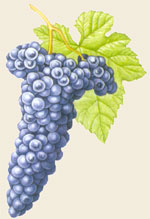


Syrah is yet another classic French variety which has been exported, and its benchmark wine style emulated, around the world. Syrah is the grape of the great Rhone wines, including Hermitage and Cote Rotie, and it is a component of Chateauneuf-du-Pape and others. Australia has taken to Syrah with enthusiasm, partly because it was one of the first grapes planted there. California is less enamoured, but a group of wine-makers is working vigorously to promote the variety and its Rhone cousins. Indeed, the homeland of Syrah, the Rhone, has much in common climatically with many New World vineyards.
Historians suggest that Syrah originated in what is now Iran, at the town of Shiraz. Ancient Greek, or even earlier, seafarers brought the vine westward, and it was being grown in southern France before the Romans arrived. Australians today call the vine Shiraz.
Syrah is relatively easy to grow as long as the climate is warm, and the crop is reliable and relatively large. It poses challenges to the winemaker, especially if it is used unblended. In everyday wines, the best use for Syrah is as a cepage ameliorateur — a vine that can add spice and interest to a blend of undistinguished grapes. Subsidies have encouraged its planting in southern France, and the distinctive smoky, rich notes of Syrah can be tasted in many a vin de fays from Provence round to the Aude.
If used unblended — as it is in the northern Rhone wines — Syrah needs careful winemaking and also, ideally, ageing in oak. The expense of this can be justified only in appellations such as Hermitage which command a premium price. A great Syrah wine can be as long-lived, complex and expensive as a first-growth claret. The connection with Bordeaux is an old one: until a century ago, Hermitage was regularly added to red bordeaux to add colour and flavour and to make the wine suitable for the important English market. Claret that had undergone this enhancement (which today would be illegal adulteration) was said to be hermitage. In a sense, the practice of using Syrah to add flavour to vins de pays is a revival of this practice.
Australia continues the tradition, by blending Syrah with Cabernet Sauvignon. This makes a relatively soft, accessible wine. Unblended Australian Syrah (or Shiraz) is potentially a better wine; but here, as in California, growers find it vital to choose warm, well-drained hillsides for the vine. Which is exactly the description of the hill of Hermitage, the vine's archetypical home.
|
|
|




